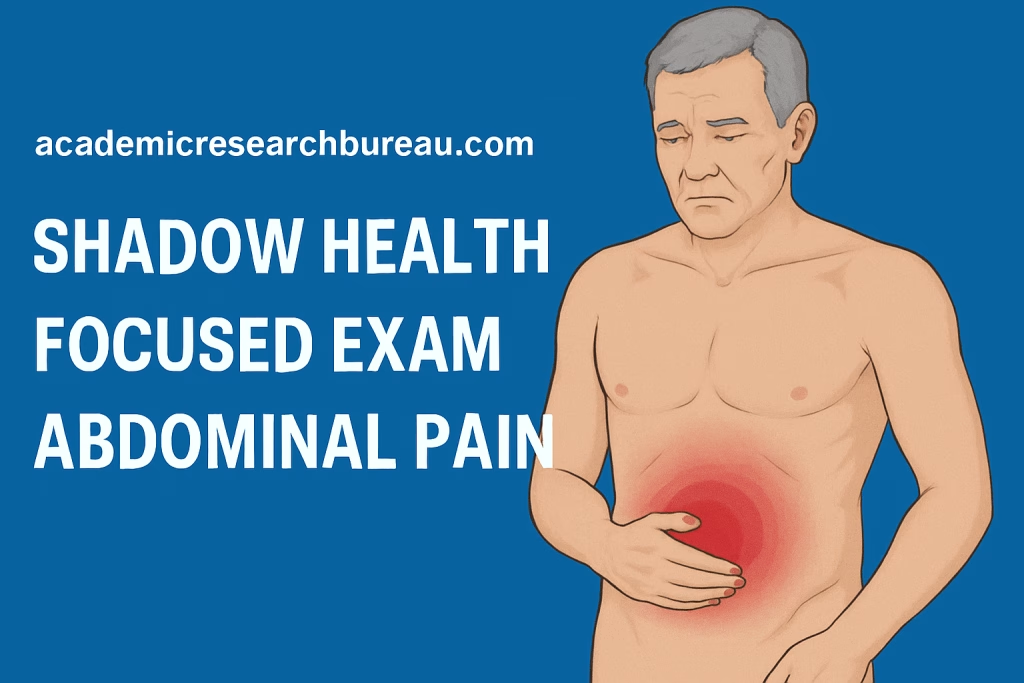Table of Contents
Toggle
Shadow Health Focused Exam Abdominal Pain
The Shadow Health focused exam abdominal pain simulation is a critical virtual patient encounter featuring Esther Park, a 78-year-old Korean woman presenting with abdominal pain. This Digital Clinical Experience™ helps nursing students develop essential assessment skills through realistic patient interactions. Over 700,000 nursing students nationwide use Shadow Health simulations as part of their clinical education, with 82% of learners showing increased efficiency in data collection and therapeutic communication skills.
Introduction: Mastering Virtual Patient Simulations
Shadow Health focused exam abdominal pain represents one of the most challenging yet essential virtual patient encounters in nursing education. As healthcare education evolves, these digital clinical experiences have become indispensable tools for developing competent, practice-ready nurses. The abdominal pain simulation, specifically featuring patient Esther Park, provides students with a comprehensive learning experience that mirrors real-world clinical scenarios.
Understanding how to approach this simulation effectively requires mastery of abdominal assessment techniques, pain evaluation protocols, and therapeutic communication strategies. This comprehensive guide addresses the critical content gaps identified in current educational resources and provides evidence-based solutions for nursing students.
Understanding Shadow Health Abdominal Pain Simulation
What is Shadow Health?
Shadow Health Digital Clinical Experiences™ are interactive virtual patient simulations designed to enhance nursing education. These platforms provide students with opportunities to practice clinical skills in a safe, controlled environment before encountering real patients. The technology has revolutionized nursing education by offering consistent, repeatable learning experiences that traditional clinical rotations cannot always provide.
The Esther Park Case Study
Esther Park, the virtual patient in the abdominal pain focused exam, presents a complex clinical scenario that requires comprehensive assessment skills. At 78 years old, she represents the growing elderly population that nurses encounter frequently in clinical practice. Her presentation includes:
- Chief complaint of abdominal pain rated 6/10
- Description of pain as constant, dull, and crampy
- Associated symptoms including bloating and decreased appetite
- Cultural considerations as a Korean-American patient
- Age-related assessment challenges
Key Learning Objectives
The Shadow Health abdominal pain simulation aims to develop several critical competencies:
- Comprehensive Health History Taking: Students learn to gather relevant information about the patient’s current complaint, past medical history, and psychosocial factors
- Physical Assessment Skills: Proper abdominal examination techniques including inspection, auscultation, percussion, and palpation
- Clinical Reasoning: Ability to synthesize assessment findings and formulate appropriate nursing diagnoses
- Therapeutic Communication: Culturally sensitive communication with elderly patients
- Documentation: Accurate and comprehensive recording of assessment findings
Statistical Impact of Virtual Patient Simulations
Recent research demonstrates the significant educational value of virtual patient simulations in nursing education:
| Metric | Percentage | Impact |
|---|---|---|
| Students using Shadow Health nationally | 700,000+ | Widespread adoption |
| Improvement in learning efficiency | 82% | Enhanced skill development |
| Clinical reasoning score improvement | Statistically significant | Better patient outcomes |
| Communication skills enhancement | Statistically significant | Improved patient interactions |
| Student satisfaction with VPS | 85%+ | High engagement levels |
Research published in Clinical Simulation in Nursing found that virtual patient simulations like Shadow Health significantly improve students’ clinical reasoning abilities and therapeutic communication skills. A pilot study showed statistically significant improvements in both areas, suggesting that VPS is an effective educational strategy.
Comprehensive Assessment Approach for Abdominal Pain
Pre-Assessment Preparation
Before beginning the Shadow Health abdominal pain simulation, students should:
- Review Anatomy and Physiology: Understand abdominal organs, their locations, and normal functions
- Study Pain Assessment Techniques: Master the use of pain scales and pain characteristic evaluation
- Practice Communication Skills: Develop culturally appropriate communication strategies
- Understand Age-Related Changes: Learn about physiological changes in elderly patients
Systematic Assessment Framework
1. Primary Survey and Vital Signs
The assessment begins with evaluating the patient’s overall appearance and vital signs:
- General appearance: Note any signs of distress, positioning, or guarding
- Vital signs: Temperature, blood pressure, pulse, respirations, and pain level
- Mental status: Assess alertness and orientation
2. Comprehensive Health History
Chief Complaint Analysis
Using the PQRST method for pain assessment:
- Provocating/Palliating factors: What makes the pain better or worse?
- Quality: How does the patient describe the pain?
- Radiation/Region: Where is the pain located and does it spread?
- Severity: Pain scale rating (0-10)
- Timing: When did it start, duration, frequency?
Associated Symptoms
Document related symptoms that may provide diagnostic clues:
- Nausea and vomiting
- Changes in bowel habits
- Urinary symptoms
- Appetite changes
- Weight loss or gain
- Fever or chills
Past Medical History
Gather information about:
- Previous abdominal surgeries
- Chronic medical conditions
- Current medications
- Allergies
- Family history of gastrointestinal disorders
Physical Examination Techniques
Inspection
- Patient positioning: Supine with knees slightly flexed
- Abdominal contour: Flat, rounded, or distended
- Skin appearance: Color, lesions, scars, or masses
- Visible peristalsis: Abnormal in adults
- Breathing patterns: Shallow breathing may indicate pain
Auscultation
Performed before palpation to avoid altering bowel sounds:
- Bowel sounds: Normal, hyperactive, hypoactive, or absent
- Bruits: Vascular sounds that may indicate arterial stenosis
- Friction rubs: Rare sounds over liver or spleen
Percussion
- Tympany: Normal over gas-filled intestines
- Dullness: May indicate masses, fluid, or organ enlargement
- Liver span: Normal 6-12 cm at midclavicular line
- Spleen: Normally not percussible
Palpation
Always palpate areas of pain last:
- Light palpation: Assess for tenderness, masses, or muscle guarding
- Deep palpation: Evaluate organ size and deeper structures
- Rebound tenderness: May indicate peritoneal irritation
- Murphy’s sign: Specific test for gallbladder inflammation
Evidence-Based Assessment Findings
Normal Assessment Parameters
| Assessment Component | Normal Findings | Clinical Significance |
|---|---|---|
| Bowel Sounds | 5-30 per minute | Indicates normal GI motility |
| Abdominal Contour | Flat to rounded | No evidence of distension |
| Skin Integrity | Intact, no lesions | Normal tissue condition |
| Palpation | Soft, non-tender | No evidence of pathology |
| Percussion | Tympany over intestines | Normal gas distribution |
Abnormal Findings in Esther Park Case
Based on the simulation, students typically encounter:
- Tender abdominal mass: Lower left quadrant finding
- Pain rating: 6/10 on numeric scale
- Associated symptoms: Bloating and appetite changes
- Behavioral indicators: Possible guarding or position changes
Cultural Considerations in Patient Care
Korean-American Health Beliefs
Understanding Esther Park’s cultural background is crucial for effective care:
- Communication Patterns: May prefer indirect communication and respect for authority
- Family Involvement: Family members often play important roles in healthcare decisions
- Pain Expression: Cultural differences in pain expression and reporting
- Traditional Remedies: Possible use of traditional Korean medicine alongside Western treatment
Culturally Competent Care Strategies
- Use appropriate titles and formal address initially
- Allow extra time for explanation and questions
- Include family members when appropriate
- Show respect for cultural practices and beliefs
- Use professional interpreters if language barriers exist
Common Student Challenges and Solutions
Challenge 1: Incomplete History Taking
Problem: Students often miss important historical information Solution: Use systematic questioning techniques and comprehensive review of systems
Challenge 2: Improper Physical Examination Sequence
Problem: Incorrect order of assessment techniques Solution: Always follow inspection → auscultation → percussion → palpation sequence
Challenge 3: Inadequate Pain Assessment
Problem: Superficial evaluation of pain characteristics Solution: Use comprehensive pain assessment tools and document thoroughly
Challenge 4: Poor Documentation
Problem: Incomplete or inaccurate recording of findings Solution: Use standardized documentation formats and practice systematic recording
Study Strategies for Success
Preparation Techniques
- Create Study Groups: Collaborate with peers to practice scenarios
- Use Flashcards: Memorize normal and abnormal assessment findings
- Practice with Standardized Patients: Gain real-world experience
- Review Video Demonstrations: Watch proper technique demonstrations
- Complete Practice Simulations: Familiarize yourself with the platform
Resource Utilization
| Resource Type | Examples | Benefits |
|---|---|---|
| Textbooks | Fundamentals of Nursing texts | Comprehensive theoretical foundation |
| Online Platforms | Quizlet flashcards, StudoCu documents | Interactive learning tools |
| Video Resources | YouTube demonstrations, institutional videos | Visual learning enhancement |
| Practice Labs | Skills lab sessions, simulation centers | Hands-on experience |
| Peer Study Groups | Collaborative learning sessions | Knowledge sharing and support |
Advanced Assessment Techniques
Special Tests for Abdominal Pain
Appendicitis Tests
- McBurney’s Point: Tenderness at junction of lateral and middle third of line from umbilicus to right iliac crest
- Rovsing’s Sign: Pain in right lower quadrant with left lower quadrant palpation
- Psoas Sign: Pain with hip flexion against resistance
Other Diagnostic Maneuvers
- Murphy’s Sign: Inspiratory arrest during right subcostal palpation (cholecystitis)
- Cullen’s Sign: Periumbilical bruising (internal bleeding)
- Grey Turner’s Sign: Flank bruising (retroperitoneal bleeding)
Technology Integration in Nursing Education
Benefits of Virtual Patient Simulations
Research demonstrates multiple advantages of incorporating Shadow Health simulations into nursing curricula:
- Consistent Learning Experiences: Every student encounters the same patient scenario
- Immediate Feedback: Real-time assessment of performance and technique
- Repeatable Practice: Students can practice multiple times without time constraints
- Safe Learning Environment: No risk to actual patients during learning process
- Objective Assessment: Standardized evaluation criteria for all students
Future of Digital Clinical Experiences
The integration of artificial intelligence and advanced simulation technology continues to enhance virtual patient experiences. Current trends include:
- Enhanced realism through improved graphics and patient responses
- Integration with electronic health records systems
- Advanced analytics for performance tracking
- Mobile accessibility for flexible learning
- Collaborative simulation experiences
Quality Improvement and Best Practices
Evidence-Based Education Strategies
Recent studies support several best practices for maximizing the educational value of Shadow Health simulations:
- Pre-Simulation Preparation: Structured orientation improves student performance
- Guided Debriefing: Post-simulation discussion enhances learning retention
- Integration with Classroom Content: Alignment with theoretical knowledge improves outcomes
- Progressive Complexity: Building from simple to complex scenarios enhances skill development
- Peer Learning: Collaborative experiences improve critical thinking skills
Assessment and Evaluation Criteria
| Performance Indicator | Excellent | Satisfactory | Needs Improvement |
|---|---|---|---|
| History Taking | Comprehensive, systematic | Complete major elements | Missing key information |
| Physical Assessment | Proper technique, complete | Generally correct | Significant errors |
| Clinical Reasoning | Accurate conclusions | Generally appropriate | Poor synthesis |
| Communication | Therapeutic, culturally appropriate | Generally effective | Needs development |
| Documentation | Thorough, accurate | Complete basics | Incomplete or inaccurate |
Frequently Asked Questions
Q: How long does the Shadow Health abdominal pain simulation take to complete?
A: Most students complete the simulation in 60-90 minutes, though time varies based on thoroughness and experience level.
Q: Can I repeat the simulation if I’m unsatisfied with my performance?
A: Policies vary by institution, but most programs allow multiple attempts for learning purposes.
Q: What resources are available if I struggle with the simulation?
A: Most institutions provide tutoring, faculty support, and additional practice opportunities.
Q: How is the simulation graded?
A: Grading typically includes completion percentages, accuracy of assessment techniques, and quality of documentation.
Conclusion: Maximizing Learning Outcomes
The Shadow Health focused exam abdominal pain simulation represents a crucial component of modern nursing education. Success requires comprehensive preparation, systematic assessment techniques, and integration of theoretical knowledge with practical skills. By understanding the cultural context, mastering assessment techniques, and utilizing available resources effectively, students can maximize their learning outcomes and develop competencies essential for professional nursing practice.
The simulation’s emphasis on Esther Park’s case provides valuable experience with geriatric patients and cultural diversity, preparing students for the realities of contemporary healthcare. As virtual patient simulations continue to evolve, they will remain essential tools for developing competent, confident nurses ready to provide safe, effective patient care.
Through careful preparation, systematic practice, and utilization of this comprehensive guide, nursing students can approach the Shadow Health abdominal pain simulation with confidence and achieve optimal learning outcomes that will serve them throughout their professional careers.
References
- Elsevier. (2024). Nursing Simulation for Nursing students | Shadow Health. Retrieved from https://evolve.elsevier.com/education/simulations/shadow-health/
- Shadow Fit Health. (2024). Digital Clinical Experiences for Nursing Education. Retrieved from https://shadowfithealth.com/
- ScienceDirect. (2024). Navigating the Virtual Frontier: A Virtual Patient Simulation Pilot Study in Prelicensure Baccalaureate Nursing Education. Retrieved from https://www.sciencedirect.com/science/article/abs/pii/S1876139924000811
- NCBI. (2024). Chapter 12 Abdominal Assessment – Nursing Skills. Retrieved from https://www.ncbi.nlm.nih.gov/books/NBK593213/
- OpenStax. (2024). Clinical Nursing Skills: Physical Assessment. Retrieved from https://openstax.org/books/clinical-nursing-skills/pages/27-2-physical-assessment
- Elsevier Research. (2023). Shadow Health Research & Articles. Retrieved from https://evolve.elsevier.com/education/simulations/shadow-health/research/
- BMC Nursing. (2023). Virtual reality simulation for nursing education: effectiveness and feasibility. Retrieved from https://bmcnurs.biomedcentral.com/articles/10.1186/s12912-023-01639-5
- Clinical Simulation in Nursing. (2014). Transformative Learning through Virtual Patient Simulations: Predicting Critical Student Reflections. Retrieved from https://www.nursingsimulation.org/article/S1876-1399(14)00030-9/fulltext
- EMS1. (2025). Mastering abdominal pain assessment: Key questions and diagnostic strategies. Retrieved from https://www.ems1.com/medical-clinical/articles/abdominal-pain-assessment-tips-to-reach-a-diagnosis-fZZbCKpfYgvGS384/
- Nursing Times. (2024). How to assess and examine a patient with abdominal symptoms. Retrieved from https://www.nursingtimes.net/assessment-skills/how-to-assess-and-examine-a-patient-with-abdominal-symptoms-29-07-2024/

I am a professional nursing assignment expert offering comprehensive academic support to university nursing students across various institutions. My services are designed to help learners manage their workload effectively while maintaining academic excellence. With years of experience in nursing research, case study writing, and evidence-based reporting, I ensure every paper is original, well-researched, and aligned with current academic standards.
My goal is to provide dependable academic assistance that enables students to focus on practical training and career growth.
Contact me today to receive expert guidance and timely, high-quality nursing assignment help tailored to your academic needs.



